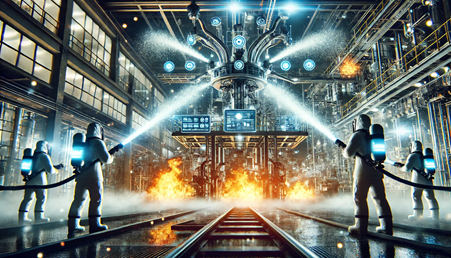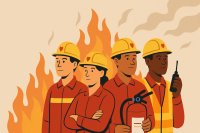
Chemical hazards pose significant risks in industrial settings, laboratories, and even commercial buildings. A fire involving hazardous chemicals can lead to toxic fumes, explosions, and environmental contamination. To mitigate these risks, fire suppression systems play a crucial role in preventing, controlling, and extinguishing fires before they escalate.
Understanding Chemical Fire Hazards
Chemical fires are different from regular fires because they often involve volatile substances that react unpredictably. Some common types of chemical hazards include:
- Flammable liquids and gases – Examples include gasoline, propane, and acetone, which can ignite quickly and spread rapidly.
- Oxidizers and reactive chemicals – These substances, such as hydrogen peroxide and chlorine, can intensify fires or cause spontaneous combustion.
- Toxic and corrosive chemicals – Fires involving chemicals like sulfuric acid or ammonia can release harmful gases that endanger human health.
Because of these dangers, traditional water-based fire suppression methods are often ineffective or even hazardous. This is where specialized fire suppression systems come into play.
Types of Fire Suppression Systems for Chemical Hazards
- Gas-Based Fire Suppression Systems
Gas-based suppression systems use inert or chemical gases to extinguish fires without damaging sensitive equipment or causing hazardous chemical reactions. Common types include:- CO₂ (Carbon Dioxide) Systems – CO₂ displaces oxygen in the affected area, suffocating the fire. This is ideal for electrical rooms, chemical storage areas, and laboratories.
- Clean Agent Systems (FM-200, Novec 1230) – These systems use non-toxic gases that suppress fires by disrupting the combustion process without harming equipment or people.
- Foam-Based Fire Suppression Systems
Foam suppression systems are particularly effective for flammable liquid fires. They work by smothering the flames and preventing oxygen from reaching the fire. Common types include:- Aqueous Film-Forming Foam (AFFF) – Used for hydrocarbon-based fires, such as those involving gasoline and oil.
- Alcohol-Resistant AFFF (AR-AFFF) – Designed for polar solvent fires, such as ethanol and acetone.
- Dry Chemical Fire Suppression Systems
Dry chemical agents are used to interrupt chemical reactions in fires. These systems are effective against Class B (flammable liquids) and Class C (electrical) fires. Popular agents include:- ABC Dry Chemical (Monoammonium Phosphate) – Suitable for general fire protection, but may not be ideal for sensitive environments.
- BC Dry Chemical (Sodium Bicarbonate, Potassium Bicarbonate) – Specifically designed for flammable liquid and electrical fires.
- Water Mist Fire Suppression Systems
Water mist systems use fine water droplets to cool the fire and reduce oxygen concentration. Unlike traditional sprinklers, they minimize water damage and are safer for areas with reactive chemicals.
Benefits of Fire Suppression Systems for Chemical Hazards
- Minimizing Fire Spread – Suppression systems act quickly to contain fires before they escalate.
- Reducing Toxic Fumes and Explosions – Certain suppression agents, like inert gases, prevent hazardous reactions.
- Protecting Equipment and Infrastructure – Gas and dry chemical systems minimize damage compared to water-based solutions.
- Ensuring Compliance with Safety Regulations – Many industries require fire suppression systems to meet occupational health and safety standards.
Conclusion
Chemical hazards present unique fire risks that require specialized suppression solutions. By using the right fire suppression system—whether gas-based, foam-based, dry chemical, or water mist—facilities can protect lives, assets, and the environment from catastrophic damage. Proper installation, maintenance, and staff training further enhance fire safety, ensuring that chemical hazards are effectively managed in any workplace.





Leave A Comment